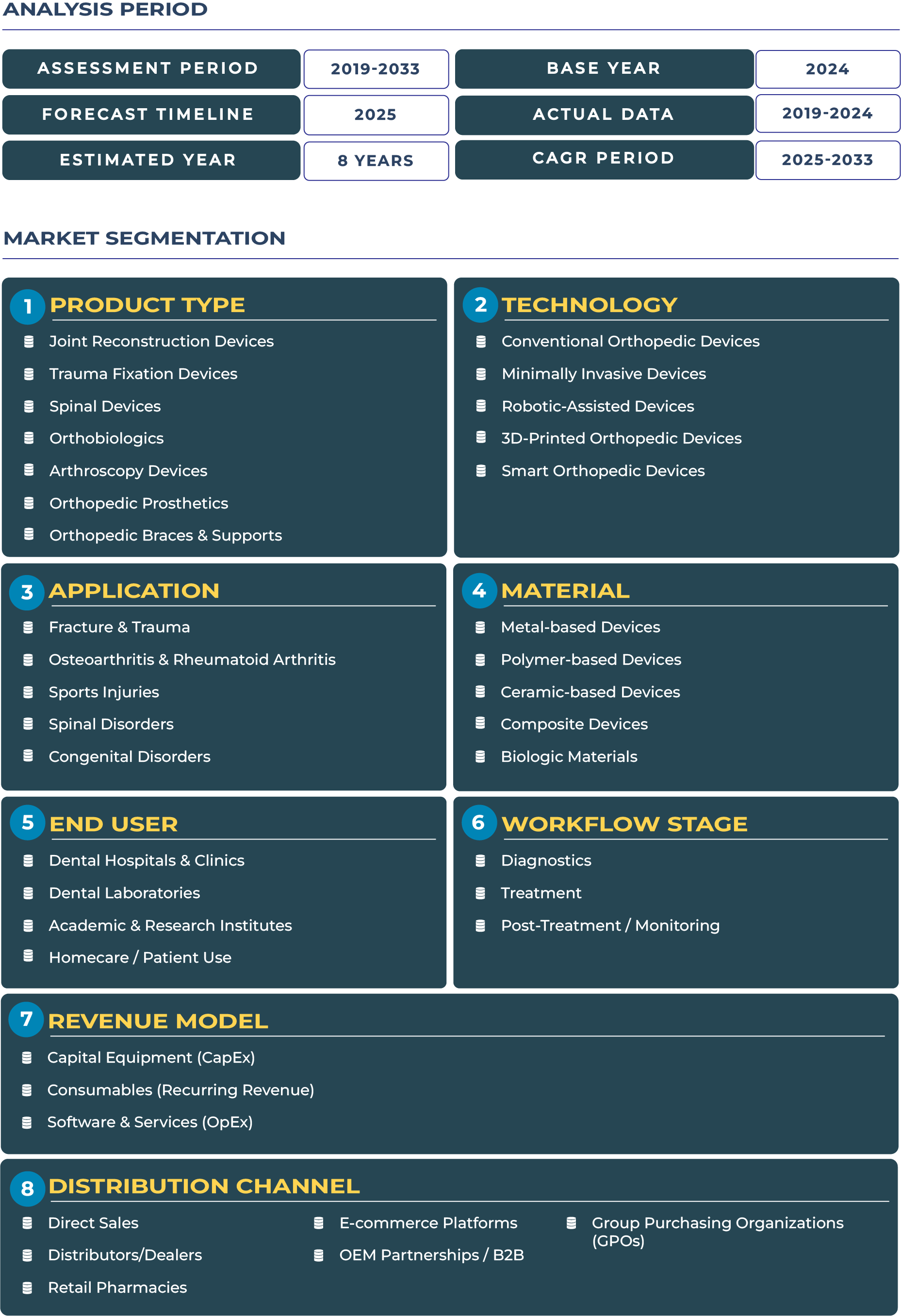Innovation-Driven Market Leadership Defining the Future of the North America Orthopedic Devices Market
North America stands as the global leader in the orthopedic devices market, powered by its strong foundation in clinical trials, advanced regulatory approvals, and the rapid adoption of cutting-edge surgical technologies. The region is home to prominent medtech innovators, robust R&D hubs, and high-volume healthcare facilities that drive orthopedic innovation from concept to commercialization. The U.S. Food and Drug Administration (FDA) continues to play a critical role by accelerating approvals for next-generation implants, robotics-assisted systems, and orthobiologics. This environment has created fertile ground for orthopedic device adoption across joint reconstruction, trauma fixation, and spinal care solutions.
The North America orthopedic devices industry is projected to expand from USD 27.00 billion in 2025 to USD 34.70 billion by 2033, reflecting a steady CAGR of 3.2% during 2025–2033. The growth trajectory is reinforced by demographic shifts such as an aging population, higher rates of osteoarthritis, and increasing demand for minimally invasive solutions. Furthermore, the rise of ambulatory surgical centers (ASCs) is reshaping procedural dynamics, driving efficiency, and reducing costs while maintaining quality outcomes. This convergence of innovation and demographic demand positions North America at the forefront of the global orthopedic devices landscape.
Drivers & Restraints Shaping the Orthopedic Devices Landscape in North America
Aging Demographics and ASC Growth Driving Market Expansion
The steady rise in demand within the orthopedic devices ecosystem is strongly linked to the aging demographics of North America. According to the U.S. Census Bureau, the population aged 65 and older is growing at nearly twice the rate of the total population, fueling increased demand for hip and knee replacements. Joint reconstruction devices remain one of the strongest growth pillars, with advanced robotics-assisted surgeries reducing recovery times and improving implant precision. Simultaneously, the rapid proliferation of private ambulatory surgical centers has created new opportunities for device manufacturers, as ASCs prioritize efficiency, patient experience, and innovative implants that reduce post-operative complications. This dual push of demographic necessity and care delivery transformation is accelerating the adoption of high-value orthopedic solutions across the region.
Reimbursement Pressure and Regulatory Risks Restricting Momentum
Despite the promising growth drivers, the orthopedic devices sector faces challenges that weigh on market performance. Reimbursement pressure remains a critical restraint as payers continue to push for outcome-based pricing models. Hospitals and surgical centers often struggle to absorb the costs of high-end implants, especially robotics-assisted devices, which have higher per-case average selling prices (ASPs). Additionally, consolidation across healthcare providers has compressed vendor access, limiting smaller players’ ability to compete effectively. Regulatory complexities, including recalls and stringent approval processes for implants, create additional risk for manufacturers. For example, product recalls in spinal and trauma fixation devices highlight the importance of stringent quality and compliance frameworks. These pressures necessitate a stronger focus on value-based contracts and operational excellence to maintain market growth momentum.
Transformational Trends and Emerging Opportunities in the Orthopedic Devices Ecosystem
Shift Toward Ambulatory Procedures and Digital Outcome Tracking
The orthopedic devices industry in North America is witnessing a notable transition toward ambulatory procedures, driven by both cost efficiency and patient-centric care models. Outpatient knee and hip replacement procedures are increasingly performed at ASCs, supported by advanced arthroscopy devices and minimally invasive techniques. Alongside procedural changes, digital outcome tracking is becoming a critical part of post-operative care. Hospitals and device manufacturers are adopting digital platforms to monitor recovery and patient-reported outcomes, ensuring accountability in value-based care models. These shifts are not only streamlining care delivery but also creating opportunities for subscription-based support services.
Recurring Revenue Models and ASC Partnerships Unlocking Future Potential
Subscription-based models for orthopedic disposables and consumables represent a key opportunity in the evolving market landscape. Manufacturers are increasingly offering bundled device and consumable solutions to generate recurring revenues while supporting predictable procurement strategies for ASCs. Partnerships with regional ambulatory surgical centers are also expanding, creating ecosystem synergies where device innovation is directly aligned with procedural efficiency. Furthermore, orthobiologics and regenerative medicine solutions are gaining traction as complementary treatments, enhancing recovery outcomes and extending implant lifespans. These opportunities illustrate the diversification strategies driving growth in the North America orthopedic devices sector.
Regional Analysis by Country
-
United States
The U.S. remains the dominant force in the North America orthopedic devices market, driven by its advanced healthcare infrastructure, leading R&D clusters, and high adoption of joint reconstruction and spinal implants. The presence of global medtech leaders headquartered in the country further amplifies its market dominance.
-
Canada
Canada is increasingly focused on expanding access to orthopedic care through government-funded programs and digital health adoption. With an aging population and growing demand for minimally invasive arthroscopy devices, Canada is positioning itself as a strong regional contributor to the orthopedic devices ecosystem.
-
Mexico
Mexico orthopedic devices industry is growing through increasing investments in private healthcare and partnerships with international device manufacturers. Demand for trauma fixation devices and orthobiologics is rising due to higher rates of road accidents and an expanding middle-class population.
Competitive Landscape: Strategic Alignments and Market Innovations Redefining the Orthopedic Devices Sector
The competitive environment in North America is characterized by the presence of global giants such as Johnson & Johnson MedTech, alongside regional innovators driving specialty product development. Recent trends include the negotiation of value-based contracts designed to align reimbursement with patient outcomes. Packaged disposable subscriptions and ASC-focused sales strategies are also gaining traction, enabling companies to optimize margins while supporting the outpatient shift. For example, in 2024, major players expanded their ASC-targeted sales teams, underscoring the shift in surgical volume away from hospitals toward outpatient facilities. With regulatory scrutiny increasing, companies are emphasizing quality-driven strategies, compliance readiness, and continuous product innovation to sustain growth in the competitive orthopedic devices landscape.








